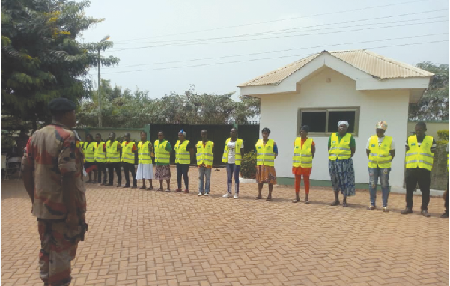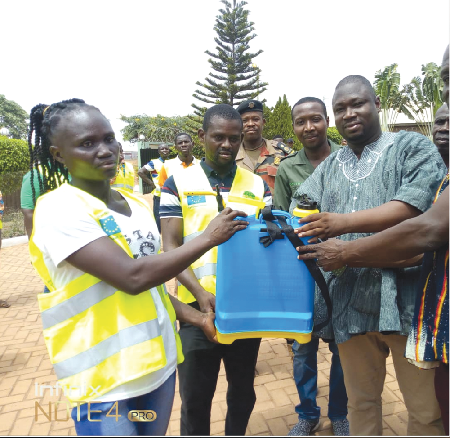Bushfires destroy crops, reserves in Bono East
The Bono East Region is one of the hubs of commercial agriculture and agribusiness in the transitional zone of the country.
The region, which has a total land mass of 23,654 square kilometres, with 11 municipal and district administration areas, is one of the biggest food-producing areas of the country.
The newly created region is said to be the fourth biggest region in the country, playing a central role in the socio-economic landscape.
Statistics available from the regional department of the Ministry of Food and Agriculture (MoFA) indicate that in 2020, the region produced 248,375 metric tonnes (MT) of maize, 2,471,206 MT of varieties of yam, 1,956,766 MT of cassava, 14,580 MT of cocoyam and 29,733 MT of plantain.
Others are 18,301 MT of rice, 23,234 MT of groundnut, 3,825 MT of sorghum, 9,899 MT of cowpea, 45,855 MT of tomatoes and 15,135 MT of pepper, among others.
It has about 44,000 hectares of low valley land for paddy rice production and more than 1,250,000 hectares of arable land for the production of grains and tubers.
Nature of soil
The soil in the area is rich in nutrients suitable for the cultivation of several food crops and supports the growing of cash or tree crops such as cashew, mango, cocoa, coconut and oil palm.
The flat nature of the land and the fact that some district lands serve as basins for tributaries of rivers and groundwater in the areas give good prospects for any future construction of irrigation systems to encourage all-year-round farming.
The rich nature of the soil and rain pattern in the area also makes it possible for farmers to farm two times each year with good yields.
Forest reserves
The region has also been blessed with three vast forest reserves, namely the Tiru Shelterbelt Forest Reserve in the Nkoranza South Municipality, Bosomoa Forest Reserve in the Kintampo South District and Buru Forest Reserve in the Kintampo Municipality.
The existence and vast nature of the reserves have helped to increase rainfall for the cultivation of food crops all year round.
Forest rangers of the Forestry Commission have had difficulty patrolling the vast forest reserves, due to the limited number of staff and inadequate logistics.
Bushfires

Personnel of the Ghana National Fire Service combating one of the recent bushfires in the Bono East Region
Notwithstanding these attributes of the region, one major problem that keeps frustrating farmers and the Forestry Commission in the area is a bushfire.
In less than two months within 2023, the region has recorded about 20 bushfires.
Farm produce, forest reserves and forest products, including trees planted under the Green Ghana initiative over the past two years, have suffered a lot of degradation as a result of bushfires.
The situation has also been attributed to the activities of farmers, palm wine tappers, hunters and cattle grazing, among other factors.
Each year, several food crops and forest investments are destroyed through bushfires, making the menace a frequent feature each dry season in the region.
In January 2020, four children of a family were burnt to death at Bonche, a farming community near Portor in the Kintampo Municipality in the region.
The deceased were Freda Stephen, seven; Nyanne Nabada, four; Nabada Uwumboryakii, three, and Faith Stephen, nine months.
It happened when the eldest of the siblings, Freda, attempted to set fire to drive away some bees that had invaded their cottage and in the process the fire gutted the structure, burning the children to death.
Fire volunteers

Zakaria Kabore (left), Public Relations Officer of the Atebubu-Amantin Divisional Fire Station, briefing the fire volunteer squad on firefighting
It is in light of the above that Tropenbos Ghana, an environmental protection non-governmental organisation, on Thursday, February 23, 2023, inaugurated fire volunteer squads in 10 fire-prone communities in three districts in the region, to help combat forest fires during the current harmattan season.
The volunteers are made up of 150 young people trained to fight the fire to protect lives, the environment and farm produce against destruction by fire in the transition landscape.
The beneficiary communities are in the Nkoranza South Municipality, Nkoranza North District and Techiman North District.
Fifteen young people from each of the 10 beneficiary communities, namely Asonkwaa, Asueyi, Tanoboase, Atrensu, Bredi-Kontonoso, Nyinase, Dromankuma, Fiema, Bonte and Konkrope were trained in how to combat bushfires to save lives and investments.
The trainees were taken through three-day vigorous firefighting techniques training to aid their face or combat bushfires.
Tropenbos Ghana organised the training which was facilitated by the Ghana National Fire Service (GNFS) and the Forestry Commission and co-funded by the European Union.
Presentation

Daniel Kofi Abu (right), Project Manager of the Tropenbos Ghana, presenting a spraying machine to one of the volunteers during the inauguration of the squad
Additionally, the organisation presented fire safety equipment to the 150 fire volunteers to enable them to fight fire when the need arises.
They included spraying machines, Wellington boots, machetes, safety wear, reflectors, goggles, gloves and torchlights, among other fighting items.
The project aims to protect the millions of trees planted in the transitional landscape under the Land Scape and Environmental Agility Across the Nation (LEAN) project, which aims at supporting national efforts to conserve biodiversity.
Additionally, the project is aim at protecting agricultural lands and promoting sustainable agriculture to ensure food security.
The rapid decline of forest
Speaking during the inauguration of the fire volunteer squads at Nkoranza in the Bono East Region, the Project Manager of Tropenbos Ghana, Daniel Kofi Abu, told the Daily Graphic that the transitional regions of the country over the years had experienced a rapid decline of forest reserves and food production.
He attributed the situation to several incidents of bushfires in the area, which he said had negatively affected food production, forest reserves and investments.
Mr Abu said the soil fertility in the area had been lost due to frequent bushfires, explaining that the NGO decided to plant trees to restore biodiversity and promote sustainable agriculture since the region was one of the food baskets of the country.


